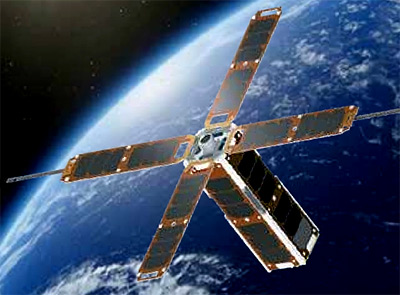Thank you very much for visiting Gunter's Space Page. I hope that this site is useful and informative for you.
If you appreciate the information provided on this site, please consider supporting my work by making a simple and secure donation via PayPal. Please help to run the website and keep everything free of charge. Thank you very much.
Dodona (La Jument 2)

Dodona [SERC]
Dodona is an experimental 3U CubeSat by the University of Southern Californiaís Space Engineering Research Center (SERC).
The satellite started as Vector Space Systems' GSky 1 satellite, developed together with Southern Californiaís Space Engineering Research Center (SERC). After the bankruptcy of the company Lockheed Martin acquired the company, while giving it a $2.5 million loan to continue to operate. The mission was continued by SERC. The satellite was renamed Dodona and will be the second mission of Lockheed Martin's La Jument program.
The satellite bus is based on the Aeneas bus. This mission intended to fly new payloads and demonstrate various control and communications techniques. A new B-Dot control algorithm will be demonstrated for optimal stability control with low power using torque rods, a rotating multi-packetized beacon transmission source to prove backup to the primary communications system, and data store and forward software to be demonstrated for non-consistent ground contacts. The Cubesat bus is a MISC-2 variant, a sister of the Aeneas design and will use the same flower petal configuration for primary solar array power.
The La Jument 3U payload on Dodona will be the first satellite to fully use Lockheed Martinís SmartSat software-defined satellite architecture on its payload. The system is powered by the NVIDIA Jetson platform built on the CUDA-X capable software stack and supported by the NVIDIA JetPack software development kit (SDK), delivering powerful AI at the edge computing capabilities to unlock advanced image and digital signal processing. SmartSat provides on-board cyber threat detection, while the software-defined payload houses advanced optical and infrared cameras utilized by Lockheed Martinís Advanced Technology Center (ATC) to further mature and space qualify Artificial Intelligence (AI) and Machine Learning (ML) technologies.
| Nation: | USA |
|---|---|
| Type / Application: | Technology |
| Operator: | University of Southern Californiaís Space Engineering Research Center (SERC) |
| Contractors: | University of Southern Californiaís Space Engineering Research Center (SERC), Lockheed Martin, Pumpkin Inc. (bus) |
| Equipment: | |
| Configuration: | CubeSat (3U) |
| Propulsion: | None |
| Power: | Solar cells, batteries |
| Lifetime: | |
| Mass: | |
| Orbit: |
| Satellite | COSPAR | Date | LS | Launch Vehicle | Remarks | |
|---|---|---|---|---|---|---|
| Dodona (La Jument 2) | 2022-002DE | 13.01.2022 | CC SLC-40 | Falcon-9 v1.2 (Block 5) | with Umbra 02, Capella 7, 8, ICEYE X14, X16, Sich 2-1, ION-SCV 004, Dodona, STORK 1, 2, LabSat, SW1FT, VZLUSAT 2, ETV A1, BRO 5, HYPSO 1, Kepler 16, ..., 19, Flock-4x 1, ..., 44, FOREST 1, Lemur-2 149, 150, Lemur-2 146, 147, DEWA-Sat 1, NuX 1, IRIS A, MDASat 1a, 1b, 1c, Gossamer Piccolomini, Tevel 1, ..., 8, Challenger, Delfi-PQ 1, Unicorn 2A, 2D, 2E, FossaSat 2E1, ..., 2E6, MDQube-SAT 1, SATLLA 2A, 2B, Unicorn 1, EASAT 2, HADES, Grizu-263a, PION-BR 1, SanoSat 1, Tartan-Artibeus 1, USA 320, ..., 323 |
